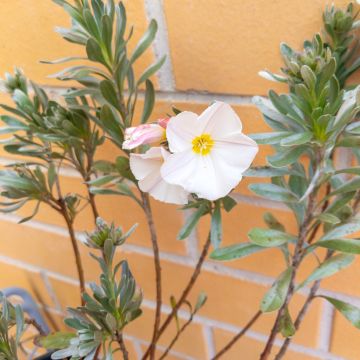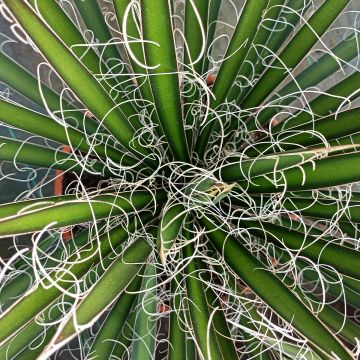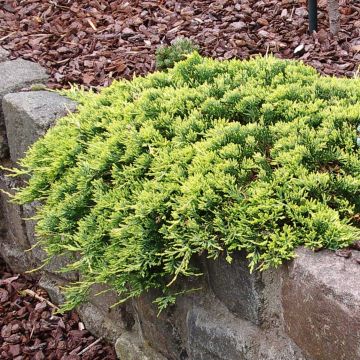

Elaeagnus ebbingei Limelight - Oleaster


Elaeagnus ebbingei Limelight - Oleaster
Elaeagnus ebbingei Limelight - Oleaster
Elaeagnus ebbingei Limelight
Oleaster, Silverberry
Product as described, well packaged.
JClaude, 29/01/2024
This item cannot be shipped to the selected country
Delivery charge from €5.90
Delivery charge from €5.90
Delivery to Corse prohibited
More information
Schedule delivery date,
and select date in basket
This plant carries a 24 months recovery warranty
More information
We guarantee the quality of our plants for a full growing cycle, and will replace at our expense any plant that fails to recover under normal climatic and planting conditions.
From €5.90 for pickup delivery and €6.90 for home delivery
Express home delivery from €8.90.
From €5.90 for pickup delivery and €6.90 for home delivery
Express home delivery from €8.90.
Delivery to Corse prohibited: UE law prohibits the import of this plant from mainland France to Corse as part of the fight against Xylella fastidiosa. Please accept our sincere apologies.
More information

Does this plant fit my garden?
Set up your Plantfit profile →
Description
Elaeagnus ebbingei Limelight is a variety of Ebbing's Oleaster with tough and shiny foliage. Beautifully speckled with yellow in the centre, on a light green background, it is ornamental even in winter. This medium-sized, well-branched shrub is also appreciated for its autumn flowering. Nestled in the foliage, its cream-white bells betray their presence with a sweet scent. The flowers give way to edible and decorative fruits, similar to small copper and silver olives. It develops quickly, even in unfavourable conditions, and tolerates pruning well. When associated with other evergreen bushes it forms a screen that is effective against the wind and is bright, colourful, elegant, and welcoming to small fauna in the garden.
The Elaeagnus ebbingei belongs to the Elaeagnaceae family. It is a horticultural hybrid that appeared in a Dutch garden in 1928, resulting from the spontaneous cross-breeding of Eleagnus macrophylla and Eleagnus pungens (possibly Eleagnus reflexa), both native to Japan. The 'Limelight' cultivar stands out with its yellow variegated foliage.
This bush offers rapid growth, good hardiness, and good resistance to summer drought. It has a bushy spreading habit and well-branched vegetation. It reaches an average height of 3m (9.8 ft) with a spread of 2.50m (6.6 ft). Its foliage consists of young silver leaves that unfold into tough, entire, lanceolate leaves, 6 to 10 cm (3.9 in) long, with a bright yellow to cream colour bordered by green, a pearly green with small bronze speckles underneath. The young stems are intensely punctuated with bronze-brown, just like the juvenile leaves in spring. The new shoots rapidly elongate in spring, with a highly ornamental rusty silver colour. The rather inconspicuous flowers appear in the axil of the leaves from September to November, and are not very visible. They are small cream-white bells, 1 to 2 cm (0.8 in) long, composed of 4 petals, and gathered in small clusters. They are deliciously scented, very honey-producing and nectar-rich. These flowers are followed by small elongated oval fruits, copper-coloured at maturity, containing an oily seed. These fruits, rich in vitamins and antioxidants, are edible for humans and appreciated by birds. When harvested ripe in April, some of these fruits have a flavour reminiscent of plums. Elaeagnus plants have a unique root system that has the ability to enrich the soil, similar to the roots of legumes.
Ideal for trimmed hedges or untrimmed and as a windbreak, Elaeagnus Limelight can also be grown as a standalone specimen and in shrub borders. It can cope in hot, dry regions in summer and in seaside gardens, as it tolerates salt spray. This bush will bring life to the slightly shady areas of the garden and add a touch of whimsy to dull borders. Pair it, in an evergreen hedge, with the classic Elaeagnus x ebbingei, Photinia Red Robin, Viburnum tinus, variegated or non-variegated Portuguese laurel, strawberry tree, Cotoneaster lacteus, Rhamnus alaternus, Mexican orange blossom or variegated Aucuba, according to your region and climate.
Report an error about the product description
Plant habit
Flowering
Foliage
Botanical data
Elaeagnus
ebbingei
Limelight
Elaeagnaceae
Oleaster, Silverberry
Cultivar or hybrid
Other Elaeagnus - Oleaster
Planting and care
The Elaeagnus ebbingei Limelight appreciates a semi-shaded site to avoid the sun scorching its foliage. It tolerates drought and sea spray as well as strong winds. Plant in spring or early autumn in any type of soil - even chalky, poor, dry or moist, but loose and well-drained. Once well established it can go completely without watering, even in hot regions. Lightly prune in the first few years to achieve the desired shape. Afterwards, simply maintain the harmony of the shape in late winter or spring so as not to compromise autumn flowering. The Elaeagnus can be affected by coral disease, and scale insects can harm it. Nevertheless, Elaeagnus are very resistant.
Planting period
Intended location
Care
-
, onOrder confirmed
Reply from on Promesse de fleurs
Evergreen shrubs
Haven't found what you were looking for?
Hardiness is the lowest winter temperature a plant can endure without suffering serious damage or even dying. However, hardiness is affected by location (a sheltered area, such as a patio), protection (winter cover) and soil type (hardiness is improved by well-drained soil).

Photo Sharing Terms & Conditions
In order to encourage gardeners to interact and share their experiences, Promesse de fleurs offers various media enabling content to be uploaded onto its Site - in particular via the ‘Photo sharing’ module.
The User agrees to refrain from:
- Posting any content that is illegal, prejudicial, insulting, racist, inciteful to hatred, revisionist, contrary to public decency, that infringes on privacy or on the privacy rights of third parties, in particular the publicity rights of persons and goods, intellectual property rights, or the right to privacy.
- Submitting content on behalf of a third party;
- Impersonate the identity of a third party and/or publish any personal information about a third party;
In general, the User undertakes to refrain from any unethical behaviour.
All Content (in particular text, comments, files, images, photos, videos, creative works, etc.), which may be subject to property or intellectual property rights, image or other private rights, shall remain the property of the User, subject to the limited rights granted by the terms of the licence granted by Promesse de fleurs as stated below. Users are at liberty to publish or not to publish such Content on the Site, notably via the ‘Photo Sharing’ facility, and accept that this Content shall be made public and freely accessible, notably on the Internet.
Users further acknowledge, undertake to have ,and guarantee that they hold all necessary rights and permissions to publish such material on the Site, in particular with regard to the legislation in force pertaining to any privacy, property, intellectual property, image, or contractual rights, or rights of any other nature. By publishing such Content on the Site, Users acknowledge accepting full liability as publishers of the Content within the meaning of the law, and grant Promesse de fleurs, free of charge, an inclusive, worldwide licence for the said Content for the entire duration of its publication, including all reproduction, representation, up/downloading, displaying, performing, transmission, and storage rights.
Users also grant permission for their name to be linked to the Content and accept that this link may not always be made available.
By engaging in posting material, Users consent to their Content becoming automatically accessible on the Internet, in particular on other sites and/or blogs and/or web pages of the Promesse de fleurs site, including in particular social pages and the Promesse de fleurs catalogue.
Users may secure the removal of entrusted content free of charge by issuing a simple request via our contact form.
The flowering period indicated on our website applies to countries and regions located in USDA zone 8 (France, the United Kingdom, Ireland, the Netherlands, etc.)
It will vary according to where you live:
- In zones 9 to 10 (Italy, Spain, Greece, etc.), flowering will occur about 2 to 4 weeks earlier.
- In zones 6 to 7 (Germany, Poland, Slovenia, and lower mountainous regions), flowering will be delayed by 2 to 3 weeks.
- In zone 5 (Central Europe, Scandinavia), blooming will be delayed by 3 to 5 weeks.
In temperate climates, pruning of spring-flowering shrubs (forsythia, spireas, etc.) should be done just after flowering.
Pruning of summer-flowering shrubs (Indian Lilac, Perovskia, etc.) can be done in winter or spring.
In cold regions as well as with frost-sensitive plants, avoid pruning too early when severe frosts may still occur.
The planting period indicated on our website applies to countries and regions located in USDA zone 8 (France, United Kingdom, Ireland, Netherlands).
It will vary according to where you live:
- In Mediterranean zones (Marseille, Madrid, Milan, etc.), autumn and winter are the best planting periods.
- In continental zones (Strasbourg, Munich, Vienna, etc.), delay planting by 2 to 3 weeks in spring and bring it forward by 2 to 4 weeks in autumn.
- In mountainous regions (the Alps, Pyrenees, Carpathians, etc.), it is best to plant in late spring (May-June) or late summer (August-September).
The harvesting period indicated on our website applies to countries and regions in USDA zone 8 (France, England, Ireland, the Netherlands).
In colder areas (Scandinavia, Poland, Austria...) fruit and vegetable harvests are likely to be delayed by 3-4 weeks.
In warmer areas (Italy, Spain, Greece, etc.), harvesting will probably take place earlier, depending on weather conditions.
The sowing periods indicated on our website apply to countries and regions within USDA Zone 8 (France, UK, Ireland, Netherlands).
In colder areas (Scandinavia, Poland, Austria...), delay any outdoor sowing by 3-4 weeks, or sow under glass.
In warmer climes (Italy, Spain, Greece, etc.), bring outdoor sowing forward by a few weeks.























































